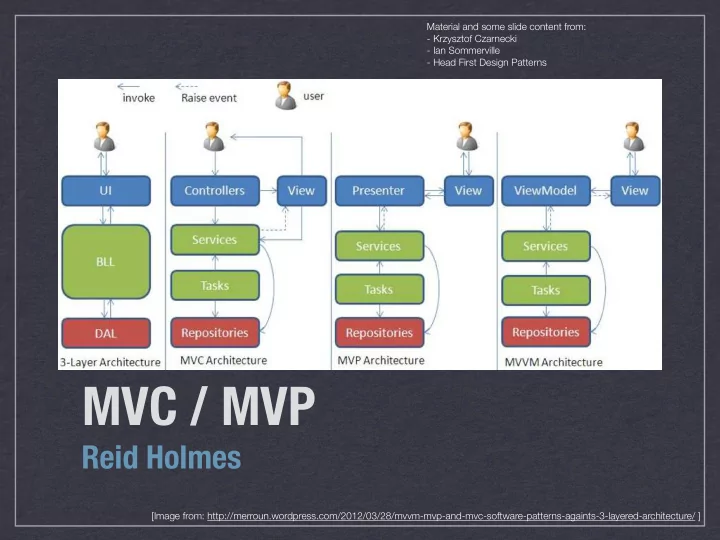

Material and some slide content from: - Krzysztof Czarnecki - Ian Sommerville - Head First Design Patterns MVC / MVP Reid Holmes [Image from: http://merroun.wordpress.com/2012/03/28/mvvm-mvp-and-mvc-software-patterns-againts-3-layered-architecture/ ]
Background ‣ MVC started w/ Smalltalk-80 ‣ Java UI frameworks & EJBs reignited interest ‣ Also prevalent in GWT and .NET development REID HOLMES - SE2: SOFTWARE DESIGN & ARCHITECTURE
MVC Motivation ‣ UI changes more frequently than business logic ‣ e.g., layout changes (esp. in web applications) ‣ The same data is often displayed in di ff erent ways ‣ e.g., table view vs chart view ‣ The same business logic can drive both ‣ Designers and developers are di ff erent people ‣ Testing UI code is di ffi cult and expensive ‣ Main Goal: Decouple models and views ‣ Increase maintainability/testability of system ‣ Permit new views to be developed REID HOLMES - SE2: SOFTWARE DESIGN & ARCHITECTURE
Model ‣ Contains application data ‣ This is often persisted to a backing store ‣ Does not know how to present itself ‣ Is domain independent ‣ Are often Subjects in the Observer pattern REID HOLMES - SE2: SOFTWARE DESIGN & ARCHITECTURE
View ‣ Presents the model to the user ‣ Allows the user to manipulate the data ‣ Does not store data ‣ Is configurable to display di ff erent data REID HOLMES - SE2: SOFTWARE DESIGN & ARCHITECTURE
Controller ‣ Glues Model and View together ‣ Updates the view when the Model changes ‣ Updates the model when the user manipulates the view ‣ Houses the application logic ‣ Loose coupling between Model and others ‣ View tightly cohesive with its Controller REID HOLMES - SE2: SOFTWARE DESIGN & ARCHITECTURE
Abstract topology 2 <<updates state>> Controller 1 Model <<changes>> 4 3 View <<retrieves state>> <<notifies of state changes>> REID HOLMES - SE2: SOFTWARE DESIGN & ARCHITECTURE
Concrete ViewController c = new ViewController(); IView v = c.createView(c); IModel m = c.loadModel(); topology m.addListener(v); [Dependency injection would remove explicit new in c.createView()] MobileView BrowserView TabletView MockView ViewController Model REID HOLMES - SE2: SOFTWARE DESIGN & ARCHITECTURE
Interaction mechanism ‣ User interacts with the UI (View) ‣ UI (View) notifies controller of changes ‣ Controller handles notifications, processing them into actions that can be performed on the model ‣ Controller modifies the model as required ‣ If the model changes, it fires modification events ‣ The view responds to the modification events REID HOLMES - SE2: SOFTWARE DESIGN & ARCHITECTURE
Benefits and tradeoffs ‣ Pro: ‣ Decouple view from model ‣ Support multiple views [collaborative views] ‣ Maintainability [add new views] ‣ Split teams [relieve critical path] ‣ Testability [reduce UI testing] ‣ Con: ‣ Complexity [indirection, events] ‣ E ffi ciency [frequent updates, large models] REID HOLMES - SE2: SOFTWARE DESIGN & ARCHITECTURE
Compound Pattern ‣ MVC (and other similar patterns) rely upon several more basic design patterns ‣ In MVC: ‣ View (strategy) / Controller (context) leverage the strategy pattern ‣ View is often uses a composite pattern (for nested views) ‣ View (observer) / Model (subject) interact through the observer pattern ‣ Other meta-patterns rely upon similar lower-level design patterns REID HOLMES - SE2: SOFTWARE DESIGN & ARCHITECTURE
MVP Motivation ‣ Take MVC a tiny bit further: ‣ Enhance testability ‣ Further separate Designers from Developers ‣ Leveraged by both GWT and .NET REID HOLMES - SE2: SOFTWARE DESIGN & ARCHITECTURE
Model ‣ Contains application data ‣ This is often persisted to a backing store ‣ Does not know how to present itself ‣ Is domain independent ‣ Often fires events to an Event Bus REID HOLMES - SE2: SOFTWARE DESIGN & ARCHITECTURE
View ‣ Thin UI front-end for controller ‣ Does not store data ‣ Can be interchanged easily ‣ Does not ever see or manipulate Model objects ‣ Only interacts with primitives ‣ e.g., (setUser(String) instead of setUser(User)) REID HOLMES - SE2: SOFTWARE DESIGN & ARCHITECTURE
Controller ‣ Glues Model and View together ‣ Updates the view when the Model changes ‣ Updates the model when the user manipulates the view ‣ Houses the application logic REID HOLMES - SE2: SOFTWARE DESIGN & ARCHITECTURE
MVP Topology View 4 1 <<notifies>> <<refresh>> Presenter 2 <<notifies of state 3 <<updates, retrieves state>> changes>> Event Bus Model REID HOLMES - SE2: SOFTWARE DESIGN & ARCHITECTURE
Concrete MVP Topology MobileView BrowserView MockView OutlineView MockOutline ViewController OutlineController App Controller App Controller can build and tear down <<notifies of state changes>> controllers. Model Event Bus REID HOLMES - SE2: SOFTWARE DESIGN & ARCHITECTURE
Concrete Example main(String[] args) { AppController ac = new AppController(); IModel m = ac.setModel(Persist.loadModel()); m.addListener(ac); ac.showMain(); } AppController::showMain() { ViewController vc = new ViewController(this); v.showMain(); } ViewController::ViewController(AppController ac) { _controller = ac; Views and presenters _controller.getModel().addListener(vc); are tightly bound: IView v = createView(); public interface IView { v.setPresenter(); public void setPresenter(Presenter p); } public void showMain(); [Dependency injection should be used public interface Presenter { in ViewController.createView()] void onCancel(); void onAction(String action); public IView createView(); } } REID HOLMES - SE2: SOFTWARE DESIGN & ARCHITECTURE
Benefits and tradeoffs ‣ Same as MVC with improved: ‣ Decoupling of views from the model ‣ Split teams [relieve critical path] ‣ Testability [reduce UI testing] ‣ A little less complex than MVC [fewer events] REID HOLMES - SE2: SOFTWARE DESIGN & ARCHITECTURE
Architecture/Design Review Meeting ‣ Don’t think of this as an oral exam ‣ Start with 5 minute presentation (board only) ‣ Followed by 25 minute discussion ‣ Evaluating the product, not the producer ‣ Be prepared! ‣ Goal: ‣ Ensure system meets proposal ‣ Check consistency of design with architecture ‣ Talk about design decisions/justification ‣ Discuss support for future system evolution REID HOLMES - SE2: SOFTWARE DESIGN & ARCHITECTURE
Recommend
More recommend